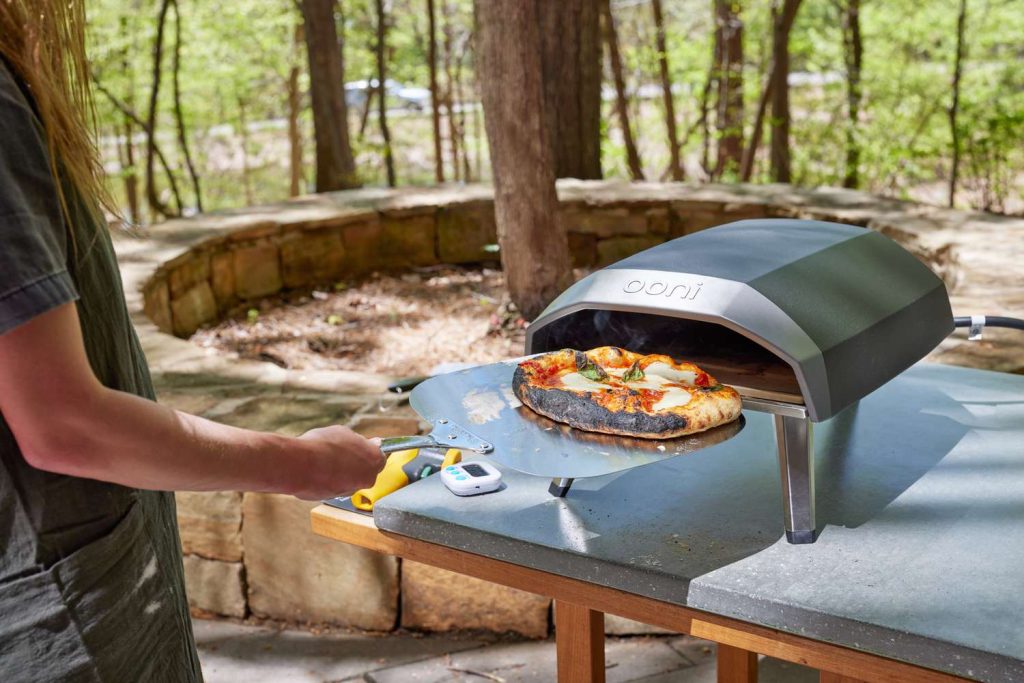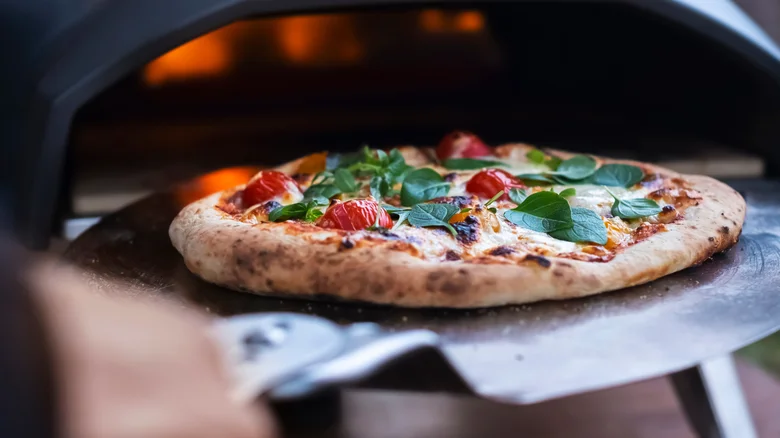Take Your Meals to the Next Level: The Ultimate Outdoor Pizza Oven Buying Guide

Imagine the tantalizing aroma of a wood-fired pizza wafting through your backyard on a warm summer evening. Friends and family gather around, eagerly anticipating the crispy, smoky masterpiece you’re about to serve. This scenario can become your reality with the right outdoor pizza oven. But how do you navigate the landscape of options to find the best outdoor pizza oven for your needs? This comprehensive outdoor pizza oven buying guide will help you explore the fascinating world of outdoor ovens and make informed decisions.
Why Should You Invest in an Outdoor Pizza Oven?
The transformative power of outdoor pizza ovens has captured the attention of home cooks and entertainers alike. These remarkable tools offer several advantages over traditional indoor ovens:
- Higher cooking temperatures for authentic, crispy crusts
- Faster cooking times, often under 2 minutes per pizza
- Unique smoky flavor that’s hard to replicate indoors
- Versatility for cooking other dishes like bread, roasted meats, and vegetables
- Perfect for outdoor gatherings and creating memorable experiences
What Types of Outdoor Pizza Ovens Are Available?

When exploring the exciting possibilities of outdoor pizza ovens, you’ll encounter three main categories:
Portable Pizza Ovens
Portable pizza ovens are ideal for those with limited outdoor space or who want the flexibility to move their oven around. They’re typically smaller, lighter, and easier to store when not in use. These ovens are great for:
- Apartment dwellers with balconies
- Renters who can’t install permanent fixtures
- Camping enthusiasts who want to enjoy pizza outdoors
Semi-Portable Pizza Ovens
Semi-portable pizza ovens bridge the gap between portable and built-in models. These ovens are larger than portable ones but can still be moved with some effort. They often come on wheels or as freestanding units. Consider a semi-portable oven if:
- You want more cooking capacity than a portable oven offers
- You’d like the option to rearrange your outdoor cooking setup
- You’re not ready for a permanent built-in installation
Built-in Pizza Ovens
Built-in pizza ovens represent a significant milestone in outdoor cooking. They’re permanent fixtures in your outdoor kitchen, usually larger, and can cook multiple pizzas at once. Consider a built-in oven if:
- You have a dedicated outdoor kitchen space
- You frequently host large outdoor gatherings
- You want a professional-grade cooking experience
How Do Different Fuel Types Affect Pizza Cooking?

The fuel type you choose can significantly impact your pizza-making experience:
Wood-Fired Pizza Ovens
Wood-fired pizza ovens offer the most authentic pizza-making experience. They impart a unique smoky flavor to the pizza and can reach very high temperatures. However, they require more skill to maintain consistent heat.
Pros:
- Authentic flavor
- High temperatures
- Traditional cooking method
Cons:
- Requires more skill to use
- Longer preheating time
- Need to source and store wood
Gas Pizza Ovens
Gas pizza ovens provide consistent heat and are easier to control. They’re more convenient for frequent use but may lack the traditional smoky flavor of wood-fired ovens.
Pros:
- Easy to use
- Consistent temperature
- Quick preheating
Cons:
- Less authentic flavor
- May require gas line installation
- Limited by gas tank capacity for portable models
Multi-Fuel Ovens
Some ovens can use multiple fuel types, offering flexibility in your cooking method. Depending on your preference or the dish you’re preparing, you can switch between wood, gas, or charcoal.
Pros:
- Versatility in cooking methods
- Can switch between authentic and convenient options
- Ideal for experimenting with different flavors
Cons:
- More complex to operate
- Usually more expensive
- May require additional accessories for different fuel types
What Key Features Should You Consider?
When evaluating outdoor pizza ovens, keep these important factors in mind:
Size and Capacity
Consider how many pizzas you’ll want to cook at once and the available space in your outdoor area. Smaller ovens are more portable but may limit your cooking options.
Pro Tip: Measure your outdoor space carefully before choosing an oven. Remember to account for clearance around the oven for safety and ease of use.
Temperature Range
Look for ovens reaching at least 800°F (427°C) for authentic Neapolitan pizza. Some cutting-edge models can reach 950°F (510°C) for even faster cooking times.
Construction Materials
High-quality materials like stainless steel, ceramic, or refractory brick ensure durability and heat retention. Insulation is crucial for maintaining consistent temperatures.
Ease of Use
Consider features like:
- Built-in thermometers for accurate temperature readings
- Easy-to-clean surfaces to simplify maintenance
- Adjustable vents for precise temperature control
- Viewing windows to monitor cooking progress without opening the door
How Much Should You Expect to Spend?
Outdoor pizza ovens range from under $150 for basic portable models to several thousand dollars for high-end built-in units. Set a budget that aligns with your needs and frequency of use.
Price ranges:
- Entry-level portable ovens: $150 – $500
- Mid-range portable ovens: $500 – $1,000
- High-end portable ovens: $1,000 – $2,000
- Semi-portable ovens: $500 – $4,000
- Built-in ovens: $3,000 – $10,000+
Investing in a quality oven can enhance your cooking experience and potentially elevate your outdoor kitchen space.
What Are the Best Pizza Oven Accessories?
To unleash the potential of your pizza oven, consider these essential accessories:
- Pizza peel: A must-have for transferring pizzas in and out of the oven. Look for wooden or metal options.
- Infrared thermometer: Ensures accurate temperature readings for perfect cooking conditions.
- Pizza cutter wheel: For clean, easy slices without dragging toppings.
- Oven brush: Helps maintain a clean cooking surface for optimal performance.
- Heat-resistant gloves: Protect your hands when working with high temperatures.
- Pizza stone: Enhances heat distribution for crispy crusts, especially in gas ovens.
- Dough scraper: Useful for handling and portioning pizza dough.
How Do You Install and Maintain Your Pizza Oven?
Installation Tips
- Ensure a level surface for your oven to prevent uneven cooking and potential safety hazards.
- Consider proximity to seating areas and wind direction to avoid bothering guests with smoke.
- Check local regulations regarding outdoor cooking appliances, especially for built-in models.
- For gas ovens, hire a professional to install gas lines safely.
Maintenance Advice
- Clean the oven after each use to prevent buildup and maintain optimal performance.
- Protect from weather when not in use with a high-quality pizza oven cover.
- Regularly inspect for any damage or wear, especially on gaskets and seals.
- Remove ash and unburned wood after each use for wood-fired ovens to prevent buildup.
Maintenance Tip: Season your pizza oven before first use to create a non-stick surface and enhance flavor. This process involves heating the oven to high temperatures with oil applied to the cooking surface.
What Are Some Expert Tips for Using Your Pizza Oven?

- Preheat the oven thoroughly before cooking. Depending on the oven type and size, this usually takes 30-60 minutes.
- Use a pizza peel dusted with flour or cornmeal for easy pizza transfer. Practice the sliding motion to avoid misshapen pizzas.
- Rotate the pizza during cooking for even browning, especially in wood-fired ovens with uneven heat distribution.
- Experiment with different wood types for unique flavors. Try applewood for a sweet smoke or hickory for a stronger flavor.
- Start with simple recipes and gradually explore new frontiers as you gain experience.
- Monitor the first few pizzas closely to understand your oven’s hot spots and cooking times.
- Allow the oven to cool naturally after use to prevent thermal shock and extend lifespan.
How Do Portable, Semi-Portable, and Built-in Pizza Ovens Compare?
| Feature | Portable Pizza Ovens | Semi-Portable Pizza Ovens | Built-in Pizza Ovens |
|---|---|---|---|
| Mobility | High | Moderate | Low |
| Size | Smaller (12-16 inch pizzas) | Medium (16-18 inch pizzas) | Larger (up to 20+ inch pizzas) |
| Installation | Easy, no permanent setup | Minimal setup required | Complex, requires professional installation |
| Price Range | $150-$2000 | $1500-$4000 | $3000-$10,000+ |
| Fuel Options | Various (wood, gas, multi-fuel) | Usually wood or gas | Usually wood or gas |
| Cooking Capacity | 1-2 pizzas at a time | 2-3 pizzas at a time | Multiple pizzas simultaneously |
| Heat Retention | Good | Very Good | Excellent |
| Aesthetic Appeal | Functional | Attractive | Can be a backyard centerpiece |
Finding the Best Outdoor Pizza Oven for You
Choosing the right outdoor pizza oven can revolutionize your backyard cooking experience and create lasting memories with friends and family. As we continue pushing the boundaries of outdoor cooking, the possibilities for creating perfect pizzas in your backyard are endless.
Consider your space, budget, and cooking preferences when making your decision. With the right oven, you’ll be crafting restaurant-quality pizzas in no time, creating memorable moments around delicious, homemade pies.
Ready to start your outdoor pizza-making journey? Use this outdoor pizza oven buying guide to make informed decisions and find the perfect oven for your needs. Happy pizza making!
FAQ
How long does it take to heat up an outdoor pizza oven?
Most outdoor pizza ovens take 15-30 minutes to reach optimal cooking temperature, depending on the fuel type and oven size. Wood-fired ovens typically take longer, while gas ovens heat up more quickly.
Can I cook other foods in a pizza oven?
Absolutely! Pizza ovens are versatile and can be used for baking bread, roasting meats, and even grilling vegetables. The high heat is perfect for searing steaks or creating crispy vegetables.
How often should I clean my outdoor pizza oven?
It’s best to clean your pizza oven after each use. Remove any food debris and ash. A thorough cleaning should be done at least once a month, depending on the frequency of use. This helps maintain optimal performance and prevents flavor transfer between uses.
What’s the average lifespan of an outdoor pizza oven?
Proper care and maintenance ensure a high-quality outdoor pizza oven lasts 10-20 years or more. Built-in brick ovens can last even longer, potentially serving your family for generations.


